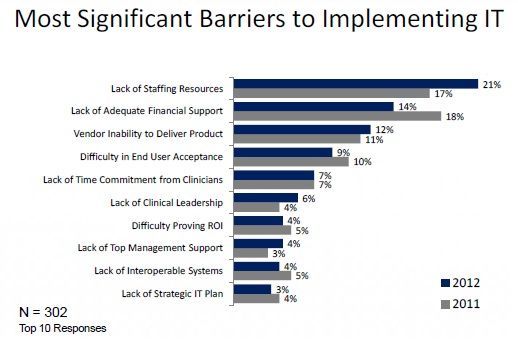Article
More IT Staffing Needed at Health Organizations
Author(s):
In the next year, the majority of health care organizations expect to increase their IT staffs to combat the largest barrier to IT implementation.
In the next year, the majority of health care organizations expect to increase their IT staffs, according to the recent HIMSS Leadership Survey. The results of the survey were released in conjunction with the HIMSS’ annual conference.
IT leaders at health care organizations reported that staffing resources were the largest barrier to implementing IT. This response is a departure from the past few years, where a lack of financial support was the key barrier. A quarter of respondents cited lack of staff and two-thirds subsequently said that they will be increasing that staff in 2012.
“It was interesting to see that staffing resources was cited by the majority of professionals as a key barrier to achieving IT implementation; given the issue has traditionally been a financial resources one,” said Jennifer Horowitz, director of research, HIMSS Analytics. “We expect that as organizations continue to invest in IT and hire to fill these positions, IT will become even more ingrained within the healthcare setting.”

The report revealed that achieving meaningful use is the most commonly cited objective for 2012, probably because of health care reform and policy mandates. Rounding out the top three were focus on clinical systems and leveraging information.
More than a quarter of respondents attested to meaningful use, and the same number said that achieving meaningful use is a key business objective for their organizations.
Approximately 75% indicated that IT could have a positive impact on patient care, citing improvements in clinical/quality outcomes, reductions in medical errors and the ability to standardize care with evidence-based medicine.
However, security is still a top concern. About one-quarter responded that their organization experienced a security breach in the last year alone.
“In recent years, the federal government has spearheaded several initiatives that require hospitals and healthcare organizations to invest in IT in order to improve the quality of care for patients, and create cost efficiencies,” Horowitz said. “As a result, health care is feeling the impact of these initiatives, as nearly three quarters of the healthcare IT professionals surveyed said these were the business issues that would drive healthcare forward.”




